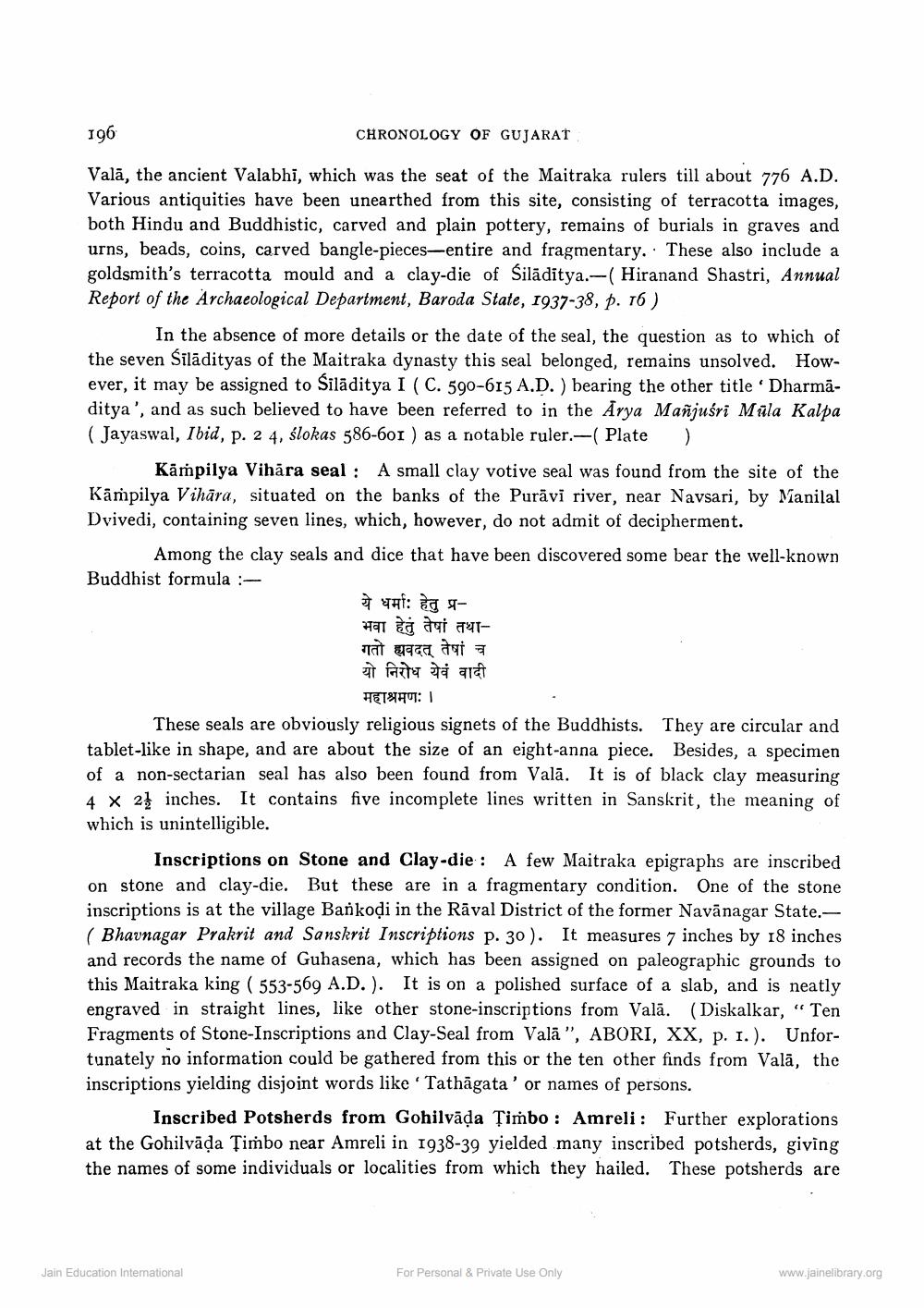________________
196
CHRONOLOGY OF GUJARAT
Valā, the ancient Valabhi, which was the seat of the Maitraka rulers till about 776 A.D. Various antiquities have been unearthed from this site, consisting of terracotta images, both Hindu and Buddhistic, carved and plain pottery, remains of burials in graves and urns, beads, coins, carved bangle-pieces-entire and fragmentary. These also include a goldsmith's terracotta mould and a clay-die of Siladitya.--( Hiranand Shastri, Annual Report of the Archaeological Department, Baroda State, 1937-38, p. 16 )
In the absence of more details or the date of the seal, the question as to which of the seven Silādityas of the Maitraka dynasty this seal belonged, remains unsolved. However, it may be assigned to Silāditya I ( C. 590-615 A.D.) bearing the other title Dharmaditya', and as such believed to have been referred to in the Arya Mañjuśri Müla Kalpa ( Jayaswal, Ibid, p. 2 4, ślokas 586-601 ) as a notable ruler.-( Plate )
Kämpilya Vihāra seal: A small clay votive seal was found from the site of the Kampilya Vihāra, situated on the banks of the Purāvi river, near Navsari, by Manilal Dvivedi, containing seven lines, which, however, do not admit of decipherment.
Among the clay seals and dice that have been discovered some bear the well-known Buddhist formula :
ये धर्माः हेतु प्रभवा हेतु तेषां तथागतो ह्यवदत् तेषां च यो निरोध येवं वादी
HET HU: These seals are obviously religious signets of the Buddhists. They are circular and tablet-like in shape, and are about the size of an eight-anna piece. Besides, a specimen of a non-sectarian seal has also been found from Valā. It is of black clay measuring 4 X 2 inches. It contains five incomplete lines written in Sanskrit, the meaning of which is unintelligible.
Inscriptions on Stone and Clay-die: A few Maitraka epigraphs are inscribed on stone and clay-die. But these are in a fragmentary condition. One of the stone inscriptions is at the village Bankoại in the Rāval District of the former Navānagar State.( Bhavnagar Prakrit and Sanskrit Inscriptions p. 30). It measures 7 inches by 18 inches and records the name of Guhasena, which has been assigned on paleographic grounds to this Maitraka king ( 553-569 A.D.). It is on a polished surface of a slab, and is neatly engraved in straight lines, like other stone-inscriptions from Valā. (Diskalkar, “ Ten Fragments of Stone-Inscriptions and Clay-Seal from Valā", ABORI, XX, p. 1.). Unfortunately no information could be gathered from this or the ten other finds from Valā, the inscriptions yielding disjoint words like 'Tathāgata' or names of persons.
Inscribed Potsherds from Gohilvāda Țimbo : Amreli: Further explorations at the Gohilvāda Timbo near Amreli in 1938-39 yielded many inscribed potsherds, giving the names of some individuals or localities from which they hailed. These potsherds are
Jain Education Intemational
For Personal & Private Use Only
www.jainelibrary.org




